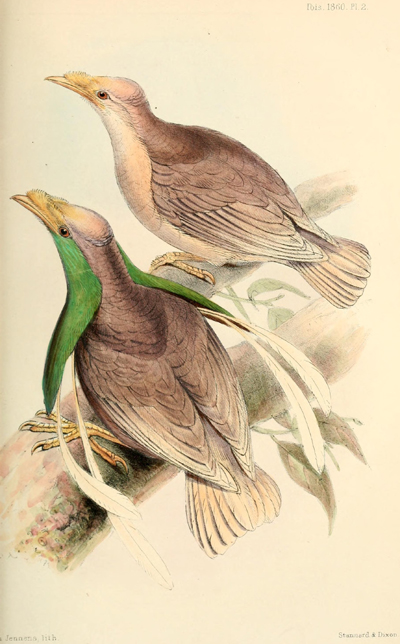IV.—Note on Wallace's Standard-wing, Semioptera wallacii.
BY PHILIP LUTLEY SCLATER.
(Plate II.)
IN accordance with the promise of further information made in last year's 'Ibis,' a representation is now given of the beautiful new Paradise-bird (or, as Mr. Gould terms it, Standard-wing) lately discovered by Mr. Wallace in the island of Batchian. By Mr. Gould's kind permission, our plate is copied from the figures of this remarkable bird recently published in the third part of his 'Supplement to the Birds of Australia.' And by the same gentleman's obliging loan of the typical examples, I am enabled to give a few remarks on its structure and natural affinities.
Mr. G. R. Gray, who first brought the Standard-wing before the notice of the scientific world at the meeting of the Zoological Society held on the 22nd of March last, agrees with the discoverer in considering it to be a Paradiseine form "approaching most nearly to the King-bird of Paradise"‡ (Cicinnurus regius). Mr.
‡ See Proc. Zool. Soc. 1859, p. 130.
Gould, however, in the 'Supplement to the Birds of Australia,' states his opinion that it is "not a Bird of Paradise, if we regard Paradisea apoda and P. papuana as typical examples of that group, but very closely allied to Ptilorhis,—so nearly so, indeed, as scarcely to be separable from that form." Now, I am not so fortunate as to be able to agree entirely with either of these authorities, considering, as I do, that the present bird is somewhat intermediate in its characters between Cicinnurus and Ptilorhis, and that it is more nearly allied to both of these forms than to the true Paradisea, though I think it probable that all three genera really belong to the same natural family. In the narrow and elongated form of the nostrils, and their concealment by short, stiff, upstanding frontal plumes which advance far beyond the openings, Semioptera agrees more closely with Cicinnurus. In Ptilorhis the nostrils are barely covered by the frontal feathers. In Paradisea the nasal opening is rounded, and quite uncovered in front. Again, the acrotarsia of Semioptera which consist of one smooth undivided scute, are very different from those of Ptilorhis, which are divided into five or six scutes; and they more nearly resemble those of Cicinnurus. The legs are also much stronger, thicker, and longer than in Ptilorhis, and in this respect are more like those of Paradisea. The wing-feathers of the new form are not so much broadened as in Ptilorhis, nor are the secondaries so much elongated; but in these respects it is equally unlike Cicinnurus. The general conformation of the wings of the three species is not essentially different. It may not be out of place to give comparative measurements of these three birds.
| Long. tota. | Alæ. | Caudæ. | Tarsi. | Rostri a rictu. | |
| Semioptera wallacii | 10·5 | 5·8 | 2·7 | 1·6 | 1·7 |
| Ptilorhis paradisea | 12·0 | 6·1 | 3·8 | 1·3 | 2·1 |
| Cicinnurus regius | 6·5 | 4·5 | 1·6 | 1·1 | 1·2 |
On the whole, therefore, it will be reasonable to consider Semioptera as a very distinct genus; and I must be allowed to express some surprise that Mr. Gould should have spoken of it as "scarcely separable" from Ptilorhis. The two very singularly elongated feathers which spring from the base of the upper
wing-coverts and extend beyond the primaries, not to speak of other differences, are, in my opinion, sufficient to distinguish it.
So much for Semioptera wallacii. It must have been with much regret that Mr. Wallace left Batchian without obtaining the second and finer species of the form which is said to exist there. Mr. Wallace's notes on the habits and living appearance of this singular bird are not yet arrived. They may probably guide us to some more certain conclusion as to its natural affinities. In the mean time those who wish to become better acquainted with its strange appearance, and to form their own judgment on the subject, have only to pay a visit to the British Museum. There, in the Bird-gallery, they will find two nicely-prepared square glass cases, in which a complete series of each of the Paradise-birds* obtained by Mr. Wallace is beautifully mounted and arranged.
* The Great Paradise-bird (Paradisea apoda) from the Arû Islands; the Lesser (P. papuana) from Havre Dorey, New Guinea; and the King (Cicinnurus regius) from the Arû Islands.

SEMIOPTERA WALLACII.